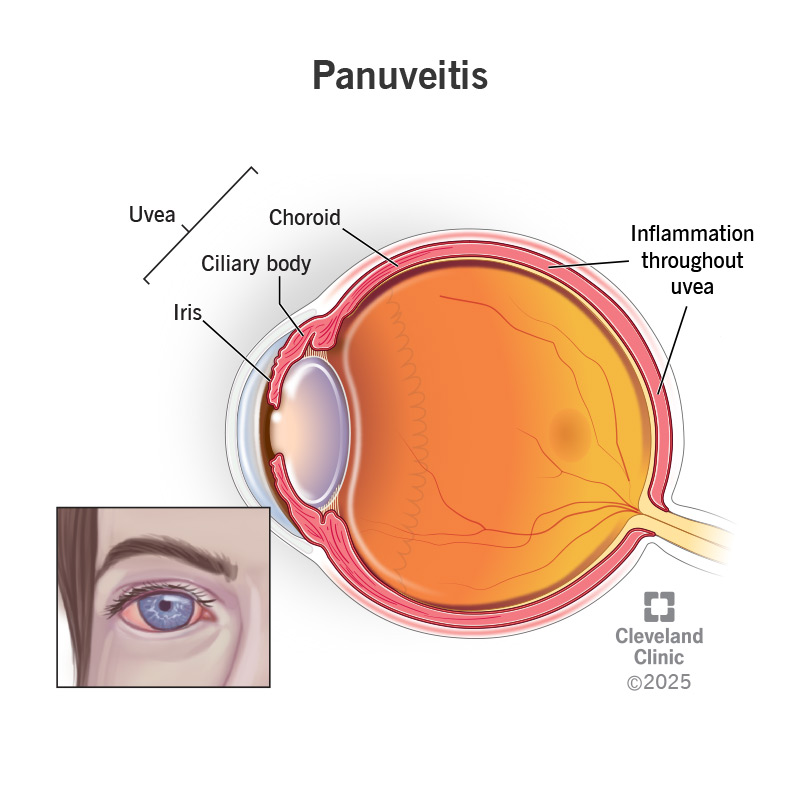Panuveitis is widespread inflammation throughout your eyeball. It causes irritation and also affects your vision. This inflammation can cause long-term damage. If you have these symptoms, seek immediate care.
Advertisement
Cleveland Clinic is a non-profit academic medical center. Advertising on our site helps support our mission. We do not endorse non-Cleveland Clinic products or services. Policy

Panuveitis is a rare and serious form of uveitis, inflammation in the middle layer of your eye (your uvea). The word “panuveitis” means that you have inflammation all throughout your uvea, from the front to the back of your eye.
Advertisement
Cleveland Clinic is a non-profit academic medical center. Advertising on our site helps support our mission. We do not endorse non-Cleveland Clinic products or services. Policy
The middle layer of your eye includes your:
Inflammation in these parts can cause irritation. It can also spread to other nearby parts, including your:
These parts are important to your vision, and inflammation in these parts can lead to vision loss.
Panuveitis can cause noticeable signs and symptoms of eye irritation and sensitivity, as well as vision changes. Having both types of symptoms is a sign that the inflammation in your eye is widespread. Seek care right away.
Signs and symptoms of panuveitis may include:
You may notice symptoms in only one eye (unilateral) or in both eyes (bilateral panuveitis).
Causes of panuveitis include infections, autoinflammatory diseases, eye trauma, certain medications and cancer. Some of these are temporary and others are chronic conditions, sometimes making panuveitis chronic, too.
Advertisement
Severe or long-lasting inflammation can do permanent damage to parts of your eye, causing permanent visual impairment. Having panuveitis raises your risk of several secondary conditions, including:
To diagnose panuveitis, an eye care specialist will ask you about your symptoms, then thoroughly examine your eye. They’ll do a slit lamp exam with additional lenses to look at the back of your eye.
Your provider will look for evidence of inflammation in all the different parts of your eye. If they find evidence in the front, middle and back parts of your uvea together, they’ll diagnose panuveitis.
Diagnosing the cause of panuveitis can be another story, especially if you haven’t had any recent eye injury or infection. Your provider will ask you all about your health history and preexisting conditions.
They might ask you questions or check for signs and symptoms that seem to have nothing to do with your eyes. This helps them narrow down possible causes. They might want to run additional tests, like:
Corticosteroids are the primary treatment for panuveitis. They’ll help bring the inflammation down to protect your vision and also treat your discomfort. This is the first priority when treating panuveitis.
Your provider may prescribe steroid pills, steroid eye drops or a steroid injection into your eye — or all of the above, depending on your condition. Some people may need to take them on a long-term basis.
You may need additional treatment for the condition causing your panuveitis, like:
These treatments can affect people in different ways. Let your provider know how they work for you and if you experience any side effects. They’ll adjust your medications until they find the right fit.
You may also need additional treatment for complications of panuveitis that damage your vision. After treating panuveitis, your provider might recommend eye surgery to treat some of these complications.
Panuveitis is treatable, but you need to get treatment right away. Some of the damage it can do is irreversible. Your prognosis will depend on how severe it is and how soon you can get treatment.
Advertisement
If you have a chronic condition that causes panuveitis, it may come back again after treatment. You might need to treat it on a recurring basis. Some people might need to take medications long-term.
The most important thing you can do to take care of yourself is to get treatment quickly. Once you do, keep in touch with your provider about how you’re doing so they can adjust your plan if needed.
While you’re recovering, it might also help to:
Panuveitis is a serious and sight-threatening condition. It’s both uncomfortable and scary. Healthcare providers treat panuveitis urgently with corticosteroids to bring the inflammation down quickly.
With treatment, you should feel better soon, and you may recover completely. But this isn’t always the end of the road for everyone. You may have a long-term condition or other complications to manage.
If you have a longer healthcare journey ahead of you, you may be facing a lot of unknowns. Whether you have a chronic disease, vision impairment or both, you may be unsure what your future holds.
Advertisement
Whatever comes next, your healthcare team will be there at every step to advise you and offer treatment options. They can also offer resources to take care of your overall health and well-being.
Advertisement
Last reviewed on 02/25/2025.
Learn more about the Health Library and our editorial process.